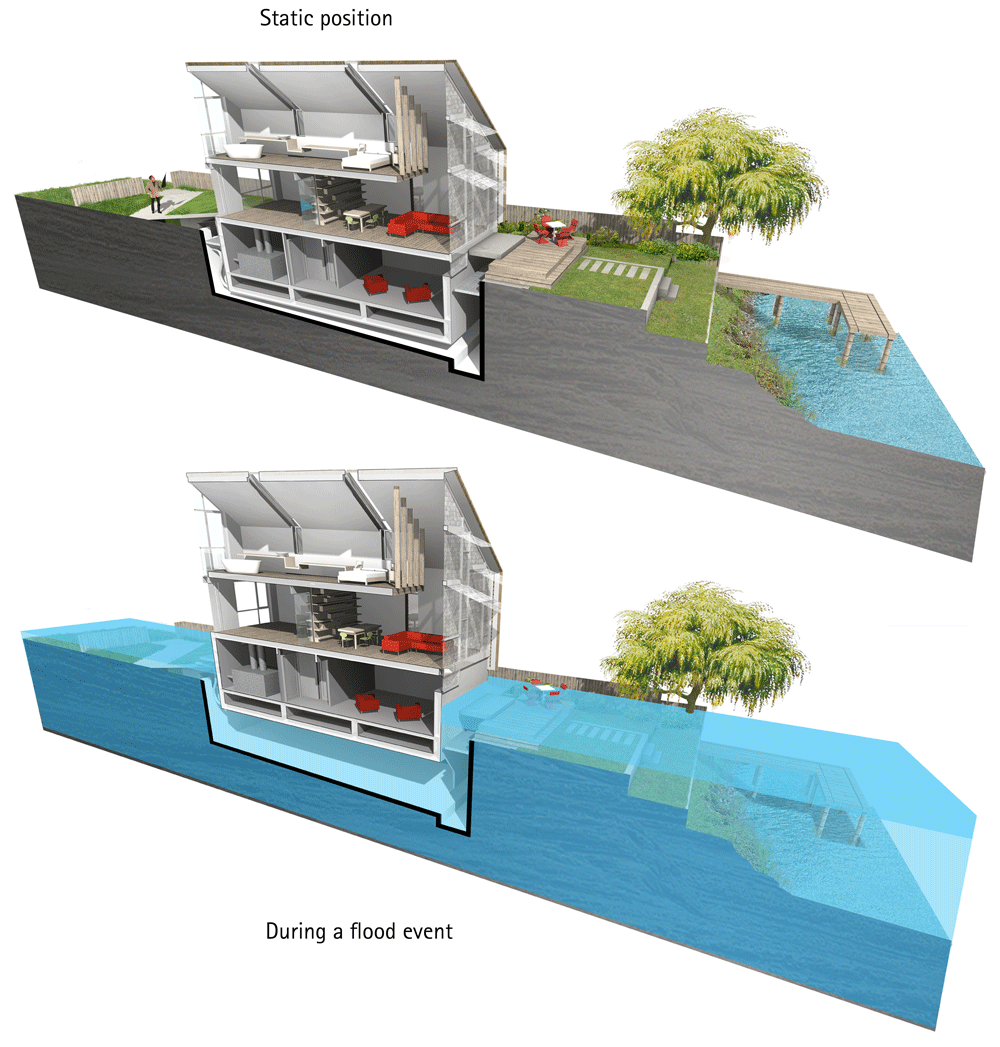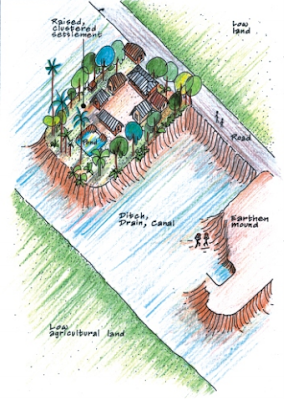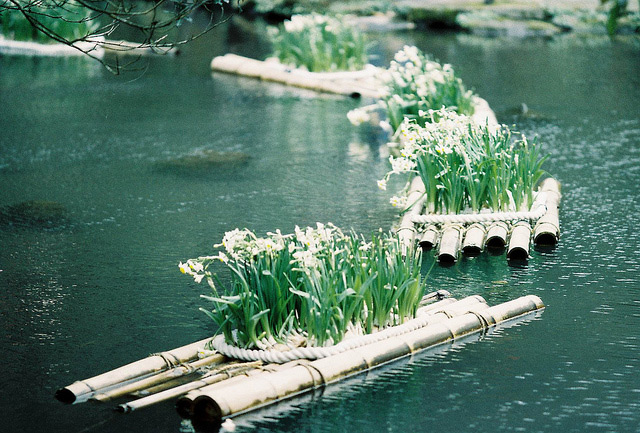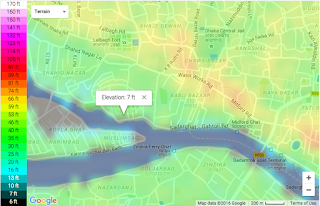Monday, February 29, 2016
Saturday, February 27, 2016
Thursday, February 18, 2016
Cost for bamboo housing?
Cost of a untreated bamboo house with thatch roof (around 200 square feet) = Tk 5,000
Cost of a treated bamboo house of same dimension = Tk 6,250
Cost increase due to preservative treatment = Tk 1,250
Cost of treatment = 25 % of the cost of untreated house
Service life of conventional untreated bamboo house = 7 years
Minimum expected service life of treated bamboo house = 15 years
That is, 25% increase in cost results in 100% increase in lifespan. 3.6
Source- http://www.adpc.net/igo/category/ID189/doc/2013-p74Wob-ADPC-handbook_complete-b.pdf
Flood resistance construction research part 2
Flood resistance construction research part 2
Source- http://www.adpc.net/igo/category/ID189/doc/2013-p74Wob-ADPC-handbook_complete-b.pdf
Cross bracing
- Increases stability and wind resistance
Wind resistant roofing
- "Roof pitch 30º- 40° to reduce effects of suction and uplift."
Rainwater gutter
- prevent rainwater from splashing on walls
- Household can use water for personal use
Bamboo construction
- "Used as supporting elements for walls and roofs
where strength is required, such as posts."
- Treated bamboo can last 15-20 years.
- Flood water shortens life span
In the PDF are methods for treating bamboo
Design Aspects
Keeping dry
- Extend leaves on roof so sides of house won't get wet.
- Rainwater gutters
- Build on raised land
Avoid ground contact
Ventilation
- Place windows strategically for cross-ventilation
- "Roof space should be left exposed to allow better airflow and
ventilation"
Protect from insects
Source- http://www.adpc.net/igo/category/ID189/doc/2013-p74Wob-ADPC-handbook_complete-b.pdf
Cross bracing
- Increases stability and wind resistance
Wind resistant roofing
- "Roof pitch 30º- 40° to reduce effects of suction and uplift."
Rainwater gutter
- prevent rainwater from splashing on walls
- Household can use water for personal use
Bamboo construction
- "Used as supporting elements for walls and roofs
where strength is required, such as posts."
- Treated bamboo can last 15-20 years.
- Flood water shortens life span
In the PDF are methods for treating bamboo
Design Aspects
Keeping dry
- Extend leaves on roof so sides of house won't get wet.
- Rainwater gutters
- Build on raised land
Avoid ground contact
Ventilation
- Place windows strategically for cross-ventilation
- "Roof space should be left exposed to allow better airflow and
ventilation"
Protect from insects
Wednesday, February 17, 2016
additional Concepts of flood proof housing
Current status of "flood proof housing" in Dhaka
Concepts
http://inhabitat.com/design/disaster-proof-design/
Possible images to be used on our boards.
http://www.all-creatures.org/hope/gw/2004-09-13_Bangladesh_flood.jpg

https://www.google.com/url?sa=i&rct=j&q=&esrc=s&source=images&cd=&cad=rja&uact=8&ved=0ahUKEwi145m20__KAhVGOj4KHYJvC3YQjhwIBQ&url=http%3A%2F%2Fnews.bbc.co.uk%2F2%2Fhi%2Fsouth_asia%2F168258.stm&bvm=bv.114195076,d.cWw&psig=AFQjCNFfBWoaL6gPkYy7eYToC6aqFXIMRw&ust=1455827804956497

https://www.google.com/url?sa=i&rct=j&q=&esrc=s&source=images&cd=&cad=rja&uact=8&ved=0ahUKEwijv8vY0__KAhVCcz4KHXoqD3MQjRwIBw&url=http%3A%2F%2Fbdnews24.com%2Fbangladesh%2F2012%2F08%2F22%2Fdhaka-second-most-flood-prone-city-study&bvm=bv.114195076,d.cWw&psig=AFQjCNFfBWoaL6gPkYy7eYToC6aqFXIMRw&ust=1455827804956497

Link: https://encrypted-tbn2.gstatic.com/images?q=tbn:ANd9GcTs7jR0ib8lR4GbITXVKWaFuYXokXmVxXk3ByA9Cd22fCS0-aNMTg

Original Neighborhoods before flooding

City of Dhaka

Image Above: Dhaka Transportation problems even before flooding

https://www.google.com/url?sa=i&rct=j&q=&esrc=s&source=images&cd=&cad=rja&uact=8&ved=0ahUKEwi145m20__KAhVGOj4KHYJvC3YQjhwIBQ&url=http%3A%2F%2Fnews.bbc.co.uk%2F2%2Fhi%2Fsouth_asia%2F168258.stm&bvm=bv.114195076,d.cWw&psig=AFQjCNFfBWoaL6gPkYy7eYToC6aqFXIMRw&ust=1455827804956497

https://www.google.com/url?sa=i&rct=j&q=&esrc=s&source=images&cd=&cad=rja&uact=8&ved=0ahUKEwijv8vY0__KAhVCcz4KHXoqD3MQjRwIBw&url=http%3A%2F%2Fbdnews24.com%2Fbangladesh%2F2012%2F08%2F22%2Fdhaka-second-most-flood-prone-city-study&bvm=bv.114195076,d.cWw&psig=AFQjCNFfBWoaL6gPkYy7eYToC6aqFXIMRw&ust=1455827804956497

Link: https://encrypted-tbn2.gstatic.com/images?q=tbn:ANd9GcTs7jR0ib8lR4GbITXVKWaFuYXokXmVxXk3ByA9Cd22fCS0-aNMTg
Original Neighborhoods before flooding

City of Dhaka
Image Above: Dhaka Transportation problems even before flooding
Tuesday, February 16, 2016
Flood
resistant construction Part
1





Handbook on design
and construction of housing for flood-prone Rural Areas of Bangladesh
Plinth

Cement stabilization
-
Mixture
of earth and cement
-
This
resist water better than an un-stabilized one.

Brick
Perimeter wall
-
Goes
around earth plinth and resist erosion from the sides

Brick and concrete
-
More
expensive option. This is more durable and flood resistant.
Post

Coating
lower end
-
Least
expensive
-
“Protects
lower end of bamboo/ timber post typically embedded into the ground”
-
“Provides
mainly damp-proofing, does not prevent much insect or fungal attack.”
-
Extends
life of bamboo by some years

Concrete
stump (Kaatla)
-
“Local
method for protecting the base of bamboo/ timber posts by supporting on
concrete stumps embedded into the plinth or ground and connecting them by MS
(mild steel) clamps.”
-
Advantage
is that bamboo posts are replaced less. Longer
life span.
(Reinforced
concrete) post
-
Expensive
option. Resistant to deterioration of water.
-
All
post should be RC.
Walls
Protection
against Rainwater Splashing and flood
Detachable lower panels
-
A
replaceable bottom part made of cheap material like straw that can be replaced
at the end of flood season. The top part won’t be affected.
Painting with bitumen
-
Done
with bamboo mat walls and CI sheet walls
-
“Molten
bitumen, Mobil or sump oil, or a combination of these can be used.”
Protective
lower panel & rainwater protector over door and gable end.
Power Systems:
As Dhaka floods, one large problem
faced by many of its residents is loss of power. As Team 8 delved further into
the discussion of power one solution we found was using flood-adaptable power
systems. One large problem that
currently affects many citizens of Dhaka is the lack of power grids, and the poor
management of the ones that are currently being used. Another statistic, taken
by the Dhaka Times, states that only 62% of Dhaka’s
population has access to power throughout the year. When Team 8 first began to
discuss short term solutions to Dhaka’s power situation, we discussed constructing
more power grids in order for a larger percentage of the population to have
access to power. Another large problem our group saw was that Dhaka, even more
specifically Islambag, currently has almost no protection from flooding, which
can easily be a reason why power grids are destroyed during even the smallest
flood. By placing power systems at higher ground and with more barriers to
protect the gird during a flood, Islambag would not have to replace its energy infrastructure
at the end of the flood season. A simple solution to protect the wires that
transfer the electricity to other areas of Dhaka would be using PVC insulated
wiring, often times used in America, to prevent the wires from water damage.
Another solution could be the use of flexible, liquid-tight, metal conduits,
which would prevent wires from extreme water damage in the case of a flood.
This seemingly simple idea can be very beneficial in protecting
mission-critical power systems.
As for long-term solutions, one possible solution is the use of hydropower systems. Hydropower is the use of either falling water, or in Islambag’s case, fast running water that can be used to create energy. Since Islambag and its surrounding area are too close to sea level in order for a hydropower system to effectively work, the system could be placed up North, closer to the border of Bangladesh and India, where the higher altitude would allow hydropower to be effectively used. The power created in Bangladesh’s northern border can then be transported to areas all over Dhaka, especially those that are in desperate need of energy.
As for long-term solutions, one possible solution is the use of hydropower systems. Hydropower is the use of either falling water, or in Islambag’s case, fast running water that can be used to create energy. Since Islambag and its surrounding area are too close to sea level in order for a hydropower system to effectively work, the system could be placed up North, closer to the border of Bangladesh and India, where the higher altitude would allow hydropower to be effectively used. The power created in Bangladesh’s northern border can then be transported to areas all over Dhaka, especially those that are in desperate need of energy.
Project Overview:
For the C.I.R.T Competition, ACE
Team 8 decided to design and reinvigorate the shoreline of Islambag, a city
within the province of Dhaka, Bangladesh. We decided on this location because it
is in desperate need of repair and rehabilitation because every flood season
(spring-summer), Islambag is completely destroyed. Our goal is for Islambag to
be well protected from floods while incorporating new technologies to advance a
city that is deeply rooted in the past. We believe the design of Islambag’s shoreline
will allow the area to see unprecedented growth, which will in turn allow the
area to grow socioeconomically. Our intention in rebuilding the shoreline is
not to replace the existing community, but allow the community to positively use
the resources they are afforded, without worry of having to move away from the
area.
Our hope was to build a shoreline
that can protect the citizens of Islambag from having to constantly move away
from their homes every flood citizen, and allow Islambag to return to full functionality
soon after the water from a flood has receded.
Team 8 decided to include ideas
from similar flood mitigation and preventive measures in areas such as Holland
and England. We feel by revitalizing the shoreline of Dhaka, the area will be
able to flourish and grow more than it ever has.
History of Dhaka:
Located along the banks of the
Buriganga River, Dhaka, even when initially settled, was full of prosperity.
After becoming the capitol of the Mughal Empire in 1610, Dhaka experienced
rapid growth, allowing it to become an empire of trade, filling it with innovation
and technological expansion. Despite the prosperity Dhaka saw, by 1666 a
decline in Dhaka’s importance began, even though the then infamous British East
India Company had set up a trading post along the shore of Dhaka. By 1704, the
Mughals moved the capitol out of Dhaka. From the 18th to the 19th
century, Dhaka remained under control of the British East India Company, mostly
exporting tea, bamboo, sugar cane and spices. Between the19th and 201th
centuries, Dhaka began to see social reform, allowing many to be exposed to a
unique blend of religious reformers, scholars, writers and artists. By the
early 20th century, it was decided that the large Bengal region
would be divided into East Bengal and West Bengal, Dhaka being the capital of East
Bengal. This partition only lasted about 7 years, eventually being abolished because
of negative sentiments. By the time the nation of Pakistan was formed, the
people of what would become Bangladesh were tired of oppressive rule and harsh
laws. Finally by 1971 the People’s Republic of Bangladesh was formed.
Today, Dhaka is a part of a
democracy with an overwhelming population of 15 million people. Dhaka contains
a vibrant culture, filled with many religions, as well as a strong educational
program. Despite the abundance of people, culture, and transportation, Dhaka is
faced annually with devastating floods. For many years, Dhaka has poured
resources into mitigating the effects of flood damage, as well as preventing
destructive flooding. Despite Dhaka’s efforts, not enough has been done to
prevent flooding, in an ever-burgeoning society.
Amphibious Home Offers Solution to United Kingdom's Flood Prone Neighborhoods
Storm-water Filtration System
Here is a design for a storm-water filtration system created by Australia's national science agency. Dhaka receives too much water during monsoon season, and a large percentage of it is wasted. The filtration system (shown above) turns the dirty storm-water into purified, potable water. This can save many lives. The main goals of this system is to protect public health and safety, and reduce flood damage.
Process Of The Filtration System:
- Water is captured in Islambag, Dhaka (South City,Dhaka).
- The captured water settles for 20 days to rid itself of the gross pollutants & fines.
- The storm-water is then treated by passing through a wetland. (this allows particles to settle)
- The water is then injected via wells into a limestone aquifer for storage and months of natural slow filtration through the aquifer.
- For extra safeguard and aesthetic quality the water was aerated, filtered through an activated carbon filter and it underwent micro-filtration and ultraviolet disinfection.
- Finally, the new water is bottled and ready to drink.
Michael Maisano ACE project
Flood adaptable construction
Humans have been adapting to their environments throughout history by developing practices, cultures and lives suited to local conditions, such as building homes on stilts to protect against monsoonal rains. However, climate change raises the possibility that existing societies will experience climatic shifts (in temperature, storm frequency, flooding and other factors) that previous experience has not prepared them for.
People have been coming up with new ways to prevent these floods, but must use them in the correct way, which must be built the right way in order for the structure to do what it is meant to do. People in Dhaka must work hard after the flood season in order to make sure they are fully prepared and ready for when the flood season comes again.
Dhaka experiences local intense rainfall, huge tans -boundary inflows and cyclone induced surges, and mass flooding that breaches the protective wall that surrounds it. These floods cover 60% of the mainland areas and towns.
After the flooding season is over, the people of Dhaka must work together in order to rebuild many of the structures that were destroyed by flooding. Materials such as bamboo, sand, and sheets of thin steel are used in re-building these destroyed homes. Those materials are all cheap and have a low-quality. Businesses and factories, on the contrary, use better quality supplies such as bricks, cement, rods, steel, concrete for the base and support.
in order for Dhaka to maintain a better city and society, it must use stronger, denser, and thicker materials, just like the ones used by factories, in order to prevent structures being damaged or destroyed by event he smallest flood. As of now the protective wall is only a 5-6 feet. The people must use the materials they have and expand the wall, with better support, to prevent destructive waters from entering Dhaka, and more specifically, Islambag.
For building and homes, cement should be used as a binder material, brick as a filler material, and steel bars as an extra support in the concrete, otherwise know as reinforced concrete.
A few of Bangladesh's contamination issues
Jonathan Tejeda Bangladesh Water Contamination
02/16/16
Overview
Bangladesh has had a history of poor water quality, and management. Latrine usage is minuscule with only about 16% of the rural areas having access to it. The death rate due to water contamination has killed over 100,000 children in the past year alone. The distribution of clean, and ample water has been a priority to the Bangladesh government since the late 70s, when a project to lessen the dependency on contaminated surface water took place. This included constructing over 10 million wells. Later new problems arose such as high arsenic concentration contaminating the well-water leaving many without clean water. This has caused many of those who depended on the well water to source back to unprotected, often contaminated ponds, ditches, etc. These unsafe methods have led to greater outbreaks of water related diseases. Aside from the rural water crisis, overpopulation, and lack of sanitation has created a similar issue in Bangladesh's urban environment. Many of those who once lived in the rural area of Bangladesh have migrated to the slums in hope of earning higher wages to support their families. Instead of solving the problem by moving out of areas with little to no clean water, overcrowding, poor housing, poverty, and poor methods of disposing of waste, have all contributed to the water contamination crisis in Bangladesh.
Arsenic Water Contamination
Arsenic contamination is an ongoing epidemic in Bangladesh that has been described as 50x worse than the Chernobyl disaster, and is affecting up to half of the 150 million people that currently live in Bangladesh. This arsenic breakout begun when wells were dug up in efforts to provide clean drinking water to those who did not have access to it. Some 10 million wells were dug up, and tapped into arsenic deposits in ground, releasing the tasteless toxin into the water supply. Bangladesh which is one of the poorest nations in the world, with about half the population earning a meager wage of 1 USD per day. This is largely why many argue that it's up to international parties to solve this issue of water contamination epidemic. Bangladesh is about half the size of Iowa, but manages to squeeze half the U.S. population. With that in mind, the United Nations in conjunction with Bangladesh government has proposed a plan to provide safe drinking water to all in 2011, but even with that, estimates say that at least 20 million people with still be exposed to arsenic laced water. The solution the the problem could be as simple as digging pass the arsenic contaminated levels, but even that is past the affordable level for most people living in Bangladesh. Another explored option was to start introducing filter, in the wells. Once again this is out of reach to one of the poorest populations in the world.http://www.nbcnews.com/id/37958050/ns/health-health_care/t/arsenic-water-killing-bangladesh/#.VsNbI_lVhBc
http://water.org/country/bangladesh/
Friday, February 12, 2016
Tuesday, February 9, 2016
FLOAT_HOUSE
Maybe we can use principles for this design in our design. Discusses some green initiatives, catching raining water etc.
http://www.aud.ucla.edu/pdfs/FLOAT_HOUSE.pdf
http://www.aud.ucla.edu/pdfs/FLOAT_HOUSE.pdf
Monday, February 8, 2016
Water Treatment
SEWAGE TREATMENT PLANS:
http://aomywork.blogspot.com/2011/11/pagla-sewage-treatment-plant-in-dhaka.html
http://dwasa.org.bd/wp-content/uploads/2015/10/Maintenance-Manual-Pagla-STP-Vol-3.pdf
WASTE MANAGEMENT:
http://globalchallenge.mit.edu/problems/view/69
http://www.bip.org.bd/SharingFiles/journal_book/20140427160816.pdf
PUMPING STATIONS:
http://www.gwp.org/Global/GWP-SAs_Files/Newslines/UrbanfloodsDhaka(final)10092012.pdf
It’s recommended not to use bamboo as concrete reinforcement because it soaks
up water in concrete causing it to swell and shrink. This can break the
concrete.

http://www.networkearth.org/naturalbuilding/bamboo.html
_________________________________________________________________________________
_________________________________________________________________________________
Nipa hut- One of the most basic examples with
bamboo.
“The walls are split and woven bamboo, and bamboo slats and poles may be
used as its support.”
Source- https://en.wikipedia.org/wiki/Bamboo_construction
_________________________________________________________________________________
Floating Garden example
_________________________________________________________________________________
Floating Garden example
Summary of Project
Every year during the months <Insert Months Here>, Islamabag is forced to rebuild itself in the aftermath of heavy flood and monsoons. Families are forced to rebuild their homes from salvage. Disease and injuries are rampant, and without medical facilities, thousands dies every year. An economy dependent on agriculture is stagnant as more than half the crop are destroyed and unnecessary amounts of resources are consumed to rebuilt the city. The people of Islamabag, who have to rebuild every year, are left without a steady livelihood. Thus, with the interest of Islamabag and its people, and the funding of companies that have a stake in Islamabag's development, we hope to remedy this problem.
Methods of Controlling Floods
Dams
- essentially designed to help in flood protection and control
- most dams have flood-control reservations where the level of a reservoir has to be maintained below a certain elevation before it rains to allow a certain amount of space in which floodwaters can fill.
- Dry dams are dams which solely aim to control floods without any conservation storage
Water-Gate
- an immediate response which can be deployed quickly
- it self-deploys using the weight of water to hold it back
Diversion canals
- redirects excess water to purpose-built canals or floodways which diverts the water to temporary holding ponds or other bodies of water where there is a lower risk or impact to flooding
- Examples of flood control channels include the Red River Floodway that protects the City of Winnipeg(Canada) and the Manggahan Floodway that protects the City of Manila (Philippines)
Self-closing flood barrier
- a flood defense system designed to protect people and property from inland waterway floods caused by heavy rainfall, gales or rapid melting snow
- It can be built to shield residential properties and communities
- It is ready to deploy whenever and can be installed in any length, using the rising flood water to deploy
River defenses
- levees, bunds (embankment to hold back water), reservoirs, and weirs are used to prevent rivers from bursting their banks.
- When these defenses fail, emergency measures such as sandbags, hydrosacks or portable inflatable tubes are used.
- A weir, also known as a low head dam, is most often used to create millponds (the pool that is created by a milldam and provides the head of water that powers a water mill)
Coastal defences
- sea walls, beach nourishment, and barrier islands.
- Tide gates are used in conjunction with dikes and culverts. Tide gates close during incoming tides to prevent water from moving upland and open during outgoing tides to let the water drain out. The opening and closing of the gates is determined by the water level difference on either side of the gate. They can be placed at the mouth of streams or small rivers, where an estuary (where the tide meets the stream) begins or where tributary streams, or drainage ditches connect to sloughs (swamps).
Asia
- In India, Bangladesh and China, flood diversion areas are rural areas that are deliberately flooded in emergencies in order to protect cities
- Deforestation is viewed as a potential cause of flooding
- With natural forest cover, the flood duration should decrease. Reducing the rate of deforestation should improve incidents and mitigate the severity of floods
http://practicalaction.org/flood-resistant_housing
Flood-resistant housing
Two-foot high concrete plinth will prevent a house being washed away.
Jute panels that cost very little yet are quick and easy to replace.
 | Jute panels make resiliant walls that cost very little yet are quick and easy to replace. Treated bamboo poles on concrete bases are strengthened with metal tie rods to hold the wall firm and safe. For all the walls in ten houses, the materials cost £62. |
 | A plinth raises a house up. Made from soil, a little cement and some pieces of stone and brick - strong and high enough to last through repeated floods, unlike the traditionalearthen floors that simply wash away. £31 pays for the casting and finishing for two floors, as well as the small amount of cement used. |
 | Animals are considered in the plans too. Crucial to the family's welfare, poultry and livestock have a separate area in the improved houses, to improve hygiene - and the henhouse can be picked up and carried to safety, out of the way of the floodwater. |
 | Bracings and fastenings bind the walls firmly to the house 'skeleton' through a network of holes and notches - locally called a 'clam system' - and the whole building can stay standing through the strongest of winds and rain. Nuts and bolts, screws, ties and nails for 20 houses come to just £120. |
 | Water-thirsty plants are set around the house, such as bamboo, banana, hogla and kolmi - they 'drink up' flood water and hold onto the soil, helping the whole homestead stay intact. Most plants can be found growing wild locally, but a little people power is needed to get them in place. |
Subscribe to:
Posts (Atom)





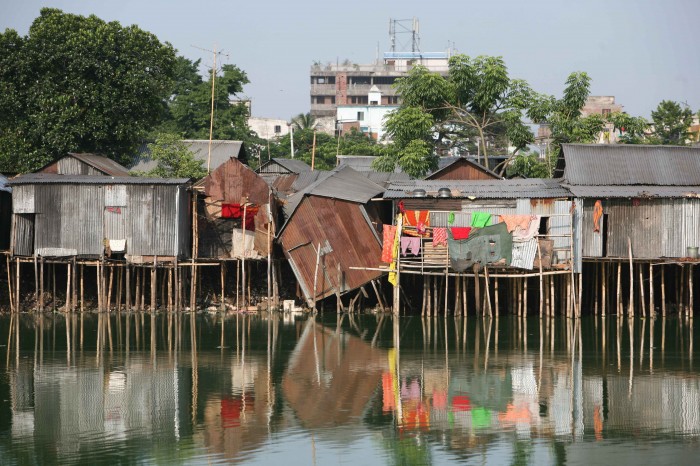
.jpg)

